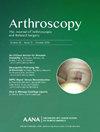骨膜自体移植和同种异体移植对髋关节股骨关节软骨高级别病变的疗效良好,但需谨慎对待嵌顿损伤和骨坏死
IF 4.4
1区 医学
Q1 ORTHOPEDICS
Arthroscopy-The Journal of Arthroscopic and Related Surgery
Pub Date : 2025-02-01
DOI:10.1016/j.arthro.2024.03.048
引用次数: 0
摘要
本文章由计算机程序翻译,如有差异,请以英文原文为准。
Editorial Commentary: Osteochodral Autograft and Allograft Show Favorable Outcomes for High-Grade Hip Femoral Cartilage Lesions, but Caution Is Required for Impaction Injuries and Osteonecrosis
Articular cartilage defects of the hip pose therapeutic challenges. Among patients undergoing hip arthroscopy for femoroacetabular impingement syndrome, more than 20% may have partial- or full-thickness chondral damage, and patients with high-grade (International Cartilage Repair Society grade 3 or 4) damage who undergo arthroscopic treatment of femoroacetabular impingement syndrome have higher rates of reoperation at 10-year follow-up. Arthroscopic and open techniques have been developed to translate cartilage restoration options initially developed in the knee for use in the hip. Arthroscopic options include chondroplasty, microfracture, biologic cartilage scaffolds, autologous chondrocyte implantation, and minced cartilage autograft (albeit more commonly in the acetabulum than the femoral head). Open techniques include autologous chondrocyte grafting, osteochondral autograft transfer (including mosaicplasty), osteochondral allograft transplantation, and arthroplasty. Open osteochondral allograft and autograft transplantation show improved patient-reported outcomes and forestall arthroplasty in young patients with high-grade cartilage defects of the femoral head. A recent review shows survivorship of 70% to 87.5% for allograft and 61.5% to 96% for autograft. At the same time, outcomes are not universally positive, particularly for patients with posttraumatic impaction injuries and high-grade osteonecrosis. Until further data better clarify the indications and contraindications, widespread adoption of open cartilage transplantation to the femoral head should be approached with caution, especially for older patients, in whom the gold standard of total hip arthroplasty has excellent survivorship at long-term follow-up.
求助全文
通过发布文献求助,成功后即可免费获取论文全文。
去求助
来源期刊
CiteScore
9.30
自引率
17.00%
发文量
555
审稿时长
58 days
期刊介绍:
Nowhere is minimally invasive surgery explained better than in Arthroscopy, the leading peer-reviewed journal in the field. Every issue enables you to put into perspective the usefulness of the various emerging arthroscopic techniques. The advantages and disadvantages of these methods -- along with their applications in various situations -- are discussed in relation to their efficiency, efficacy and cost benefit. As a special incentive, paid subscribers also receive access to the journal expanded website.

 求助内容:
求助内容: 应助结果提醒方式:
应助结果提醒方式:


